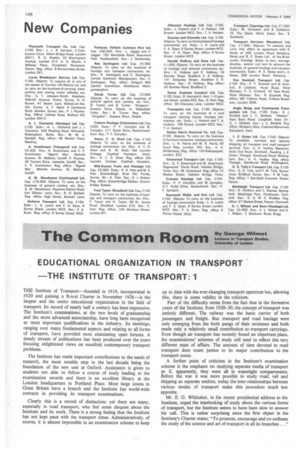The Common Room
Page 148

If you've noticed an error in this article please click here to report it so we can fix it.
By George Wilmot
Lecturer in Transport Studies, University of London
EDUCATIONAL ORGANIZATION IN TRANSPORT THE INSTITUTE OF TRANSPORT: 1
THE Institute of Transport-founded in 1919, incorporated in 1920 and gaining a Royal Charter in November 1926-is the largest and the senior educational organization in the field of transport. Its record of nearly half a century has been impressive. The Institute's examinations, at the two levels of graduateship and the more advanced associateship, have long been recognized as most important qualifications in the industry. Its meetings, ranging over many fundamental aspects and relating to all forms of transport, have provided most stimulating open forums. A steady stream of publications has been produced over the years focusing enlightened views on manifold contemporary transport problems.
The Institute has made important contributions to the needs of research, the most notable step in the last decade being the foundation of the new unit at Oxford. Assistance is given to students not able to follow a course of study leading to the examination awards and there is an excellent library at the London headquarters in Portland Place. Most large towns in Great Britain have a branch and the Institute has world-wide contacts in providing its transport examinations.
Clearly this is a record of distinction; yet there are many, especially in road transport, who feel some disquiet about the Institute and its work. There is a strong feeling that the Institute has not kept pace with the transport times. Administratively, of course, it is almost impossible in an examination scheme to keep up to date with the ever-changing transport spectrum but, allowing this, there is some validity in the criticism.
Part of the difficulty stems from the fact that in the formative years of the Institute, from 1920-30, the concept of transport was entirely different. The railway was the basic carrier of both passengers and freight. Bus transport and road haulage were only emerging from the birth pangs of their existence and both made only a relatively small contribution to transport carryings. Even though air transport has recently found an important place, the examinations' schemes of study still tend to reflect this very different state of affairs. The amount of time devoted to road transport does scant justice to its major contribution to the transport scene.
A further point of criticism in the Institute's examination scheme is the emphasis on studying separate media of transport as if, apparently, they were all in watertight compartments. Before the war it was more possible to study road, rail and shipping as separate entities; today the inter-relationships between various modes of transport make this procedure much less apposite.
Mr. E. G. Whittaker, in, his recent presidential address to the Institute, urged the interlocking of study about the various forms of transport, but the Institute seems to have been slow to answer his call. This is rather surprising since the first object in the Institute's Charter states: "To promote, encourage and co-ordinate the study of the science and art of transport in all its branches ..."




































































































































































































